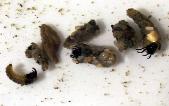
Smoky Mountain streams. Little
River has plenty of this species.
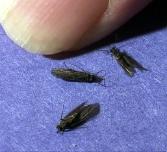
the most important stage of this
insect – the pupae are. It is much
more productive to fish an
imitation of the pupa than the
adult of this species.
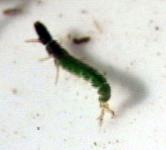
is not the most important stage
of this insect – the pupa is. It is
much more productive to fish an
imitation of the pupa than the
adult Cinnamon Sedge.
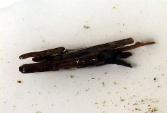
of the Northern Case Makers.
Limnephilidae family species
are somewhat plentiful.
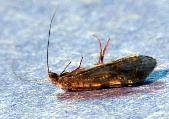
not very plentiful. These do
deposit their eggs late in the
day and trout can be taken on
imitations of them.
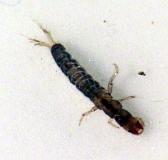
plates behind their heads. They
feed from a silk thread strung out
from their little houses.
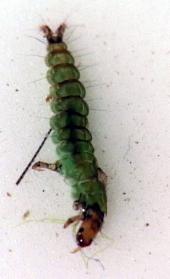
Caddisflies, especially the net-spinning caddisflies, are not very plentiful in the Smokies but some species do exist in abundant quantities in some cases. The leaf shredders, free-living, and predator caddisflies are present. There are many different genera with numerous species of them that can be found in the park. It is important to be able to recognize which ones are fairly prevalent and which ones are usually not.
Click for Recommended Caddisfliy Imitations (Flies)
Most anglers do not recognize a caddisfly hatch until it is too late to do them any good. They wait until they spot the adults flying around the banks or on the stream side vegetation before they make any effort to imitate them. At that point in time they may never even touch the water. After they have hatched the only time they are going to be important to the angler is when the females deposit their eggs. This may be a day or several days away. This may occur at night and often does. They can attempt to deposit their eggs several times, repeating the action.
They deposit their eggs sometimes from the air and don’t touch the water. Some species crawl into the water from the banks and rocks to deposit their eggs on the bottom. Many of them dive and paste them on the bottom. Others drop them by touching the water.
Some of them swim to the surface and hatch similar to a mayfly. Others emerge on the bottom and swim to the surface to fly away. Still many of them crawl out of the water on the bottom and up on rocks, sticks or the bank to hatch. Some of them even swim to the surface, hatch and run to the banks on the surface of the water. Unless you know which way the particular species of caddisfly emerges and how it goes about depositing its eggs, you are guessing at trying to imitate its behavior. Tying on an elk hair caddis and fishing it dead drift works in about 10% of the cases where adult caddisflies are observed and doesn’t work in about 90% of the cases.
Little Black Caddis:
One of the most important and overlooked hatches in the park is the Little Black Caddis usually called the “Mothers Day Hatch” in many other places. These are Brachycentridae family species of the Brachycentrus genus. During the winter or early spring you can observe the chimney cases attached to rocks in the stream in most of the streams in the Great Smoky Mountains National Park.
These caddisflies hatch in the early spring or late winter months when the water is 48 to 52 degrees F., during the afternoon in a manner similar to mayflies. This hatch usually starts just prior to the Quill Gordon mayfly hatch. It can last up to a month or more depending on weather stability.
The pupae swim to the surface and hatch into adults. The adult caddis ride the water a short time and fly away. They deposit their eggs by touching the water with their abdomens, so catching trout during the ovipositing period is very productive. This usually occurs from mid-afternoon until dark.
These caddisflies are a hook size 16 or 18, depending on their sex, in all 3 stages of life.
Green Sedge:
The Green Sedge, sometimes called the Green Rock Worm because of its larva stage, can occasionally be found in some of the park’s streams. The Green Sedges or Rhyacophila species also usually hatch in sparse numbers. Abrams Creek has a substantial quantity of them but they are also present in many other streams such as Little River.
The Green Sedge rock worm or larvae are free living larvae that are readily taken by trout. They do not build cases except the short period of time when they change to the pupae stage. They are available throughout the year. There are several species of them in the park. They range in hook size from 14 to 18. You will find them in the fast water and riffles. The larva stage is by far the most important stage to imitate. The adult stage of this mayfly is rarely found in numbers large enough to justify imitating. It is best to imitate the larvae stage of the Green Sedge.
Little (Short-Horned Sedges) Caddis:
Little Short-Horned Sedge are fairly plentiful in some of the streams. These are saddle cased larvae. You will find some of the Glossosoma species that provide some intense hatches. They are about a hook size 20 to 22. The emergers are the most important stage because they emerge mid-stream and stay on the water until they get to the banks. They dive to deposit their eggs. You would imitate this with a wet fly imitation.
Tiny Black Caddis:
Chimarra species, called Tiny Black Caddis, are occasionally found in some of the park’s streams. These are a hook size 20. These crawl out of the water usually on rocks to hatch during the day and deposit their eggs in the afternoons. They hatch when the water is about 45-50 degrees.
Cinnamon (Spotted) Sedges (Abrams Creek):
You will also find some of the net-spinning caddisflies that hatch in the spring. These are mostly Ceratopsyche species called Cinnamon Sedges. You also may find them in some other streams by they are usually very low quantities of them. The pupa stage is the best stage of life to imitate. The egg ovipositing can also create some action from the trout. This happen just before and after dark. These are a hook size 16 to 18.
Little Sister Caddis (Little Olive Sedge) (Abrams):
Cheumatopsyche species or Little Sister Sedges also hatch in Abrams Creek. These are also net-spinning caddisflies. They can be found in some other streams but never in any appreciable concentration. It is best to imitate the pupae stage of this caddisfly. If you find the rocks slick in a stream, you may find some of these and the other net spinners. The egg layers can be imitated effectively just before dark. These are a hook size 20-22.
Great Brown Autumn Sedge:
The Limnephilidae family of caddisflies, called Northern Casemakers, have some genera present in the park streams. Probably the most important is the Great Brown Autumn Sedge. This is a larger caddisfly that has a cinnamon colored body and brown to yellowish brown wings. The problem with them for anglers is that they both emerge and deposit their eggs during the night. This occurs in the fall of the year. You will find their large cases, built of wood, around the edges of most of the streams. They are a hook size 10-16.
Long Horn Sedges:
There are some members of the Leptoceridae family of caddisflies in the Smokies but they are few and far between. We have only found a few of these long-horn caddisflies. One reason is that they prefer moderate to slow water. These are a hook size 16 to 20 depending on the genus.
Little Gray Sedge:
The Little Gray Sedges are Goera species of the Limnephilidae family. They have dull yellow bodies and tannish gray wings. Many anglers just refer to them as tan caddis. They hatch in the late spring in the riffles. These caddisflies can hatch in larger quantities depending on the particular location on the stream. They are a hook size 18.
Others:
There are several other species of caddisflies found in the park but none of them that we have encountered hatch in large quantities. If you have larva, pupa and adult imitations of the above caddisfly species we feel sure you will have something close enough to imitate any of the other species you may encounter.
Click for Recommended Caddisfliy Imitations (Flies)
Copyright 2011 James Marsh

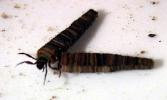
Brachycentrus specie of caddisflies are among the most overlooked insects that trout feed on in the park. The adults of this species are known as “Little Black Caddis”. Species of this same genus are also known as the “Mothers Day Hatch” in some locations because they hatch in the Spring near Mothers Day. Don’t confuse these with the Tiny Black Caddis to the left. They emerge entirely differently. The American Grannom cases are called chimney cases.
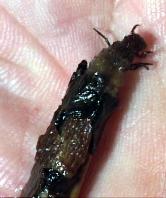
in many streams. Little River has
plenty of this species. Look close
and you will see the head of the
larvae sticking out the end of the
case. These sticks can crawl.
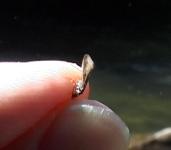
These are sometimes spotted
during the fall months. They
deposit their eggs at night and
are not important to imitate.

difficult to identify even down to
the genus level. You get a much
better opportunity of identifying
them in their larvae stage of life.
This e is fairly easy to identify. It’s
a Spotted Sedge. The one below
is a Cinnamon Sedge.

